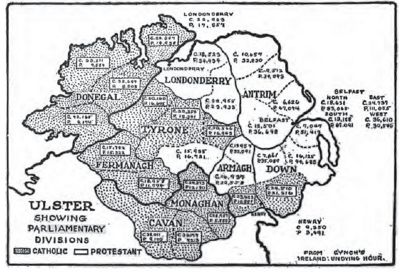Northern Ireland: Difference between revisions
imported>Mal McKee |
imported>Mal McKee |
||
| Line 4: | Line 4: | ||
==Geography== | ==Geography== | ||
Northern Ireland consists of | Northern Ireland consists of six of the counties of Ulster: Antrim, Armagh, Derry, Down, Fermanagh and Tyrone; with Cavan, Donegal and Monaghan being part of the Republic of Ireland. The region is bordered with the [[North Sea]] on its North coast, the Irish sea on its East coast and the Republic of Ireland to the South and West. | ||
==Economy== | ==Economy== | ||
==Government== | ==Government== | ||
Revision as of 09:22, 30 August 2008
Northern Ireland is a region of the British Isles, situated on the island of Ireland, to the north and east of the Republic of Ireland. It is separated from Scotland by the North Channel. Northern Ireland was established by the Government of Ireland Act, 1920, and it is a constituent part of the United Kingdom. It has been a tumultuous spot of perennial strife between the supporters of its union with the U.K. (Ulster Unionism), and supporters of its unification with the Republic of Ireland (Irish Republicanism).
Geography
Northern Ireland consists of six of the counties of Ulster: Antrim, Armagh, Derry, Down, Fermanagh and Tyrone; with Cavan, Donegal and Monaghan being part of the Republic of Ireland. The region is bordered with the North Sea on its North coast, the Irish sea on its East coast and the Republic of Ireland to the South and West.
Economy
Government
Culture
Northern Ireland shares much of its culture, in a historical sense, with that of the rest of Ireland and with the rest of the United Kingdom. It has also produced people, ideas, industry and other things which have influenced the rest of the British Isles.
Many people from the region, before the Republic of Ireland separated from it, moved to foreign shores and they or their ancestors became predidents of countries such as the United States of America, Canada and New Zealand, or became otherwise influential in various fields.
The region has produced literature from the Ulster Cycle of tales, through Weaver poetry to Seamus Heaney. Writers such as Oscar Wilde and Samuel Beckett were educated in the area. Other writers of note are Brian Friel, C. S. Lewis and Colin Bateman.
Film and television has been graced by stars from Northern Ireland also, including Stephen Rea, Kenneth Branagh, James Nesbitt, Ciarán Hinds, Liam Neeson, Sam Neill, Derek Thompson, Colin Blakely, James Ellis and Amanda Burton
Its turbulent history has produced a wealth of literature from popular music and poetry to novels, films and plays, as well as political innovations.
In popular music, Northern Ireland has produced acts such as Stiff Little Fingers, The Undertones, Snow Patrol, Ash, Gary Moore, Neil Hannon, Therapy and Van Morrison. The record-setting Ruby Murray was from Belfast's Donegall Road and James Galway brought the flute to popular attention.
In the field of sports Northern Ireland, given it's relatively small population, has produced a plethora of top-rate athletes and experts such as George Best, Darren Clarke, Joey Dunlop, Alex Higgins, Denis Taylor, Eddie Irvine, Dave McAuley, Willie John McBride, Wayne McCullough, David Healy, Norman Whiteside, Martin O'Neill and the Olympic gold medallist Mary Peters.
The region included two of the most important centres of learning and religious instruction, Bangor and Movilla (now Newtownards), from which missionaries spread Christianity throughout the British Isles and Europe.
History
See:
Historiography
Regan (2007) asks to what extent has the recent war in Northern Ireland influenced Irish historiography? Examining the nomenclature, periodization, and the use of democracy and state legitimization as interpretative tools in the historicization of the Irish Civil War (1922–3), the influence of a southern nationalist ideology is apparent. A dominating southern nationalist interest represented the revolutionary political elite's realpolitik after 1920, though its pan-nationalist rhetoric obscured this. Ignoring southern nationalism as a cogent influence has led to the misrepresentation of nationalism as ethnically homogeneous in twentieth-century Ireland. Once this is identified, historiographical and methodological problems are illuminated, which may be demonstrated in historians' work on the revolutionary period (c. 1912–23). Following the northern crisis's emergence in the late 1960s, the Republic's Irish governments required a revised public history that could reconcile the state's violent and revolutionary origins with its counterinsurgency against militarist-republicanism. At the same time many historians adopted constitutional, later democratic, state formation narratives for the south at the expense of historical precision. This facilitated a broader state-centred and statist historiography, mirroring the Republic's desire to re-orientate its nationalism away from irredentism, toward the conscious accommodation of partition. Reconciliation of southern nationalist identities with its state represents a singular political achievement, as well as a concomitant historiographical problem.[1]
